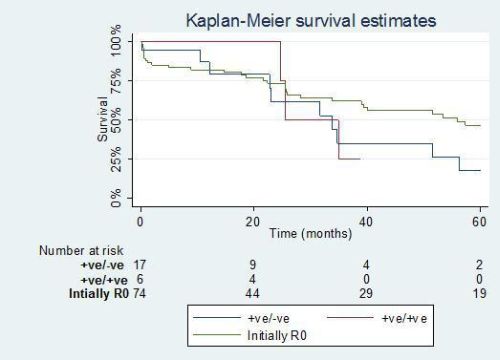|
Back to 2015 Annual Meeting Program
Clinical Significance of Re-Resection of Margin-Positive Proximal Bile Duct in Hilar Cholangiocarcinoma
Carlos a. Puig*, Kristopher P. Croome, David M. Nagorney
Department of subspecialty general surgery, Mayo Clinic, Rochester, MN
Background:
Frozen section analysis is routinely used to assess and guide the extent of resection for hilar cholangiocarcinoma. The survival benefit of intraoperative re-resection of positive proximal bile duct margins has been questioned in recent literature.
Methods:
The association between initial negative proximal bile duct margins, positive-to-negative margins and positive-to-positive with overall survival and recurrence was assessed. Data was obtained retrospectively for 97 patients between 1993 and 2014. Patients were identified using data discovery and query builder (DDQB) and data was entered in a prospectively maintained database.
Results:
Frozen section examination of the proximal bile duct margin was done in 97 patients. Histopathologic diagnosis of resected margins was negative in 74 patients (76%) and positive in 23 (23%). Additional resection was performed in the 23 patients. With additional re-resection a negative margin was achieved in17 (17%) and positive in 6 (6%). Median survival (months) for initial negative margins (-ve), positive-to-negative (+ve/-ve), and positive-positive (+ve/+ve) was 55.9, 33.8 and 25.5, respectively. There was trend toward inferior survival for patients with +ve/-ve compared to initially R0 and +ve/+ve compared to +ve/-ve. This trend became more apparent after 2 years postoperatively. Positive lymph nodes were present in 25 (33.8%) of initial R0, 8 (47.1%) of (+ve/-ve), and 4 (66.7%) of (+ve/-ve). Median CA 19-9 for initial positive, (+ve/-ve) and (+ve/-ve) was 85, 61 and 93 U/mL, respectively.
Conclusions:
All patients with initially +ve margins had a trend of inferior survival compared to those with initially R0, likely related in part to their associated higher stage disease. Additionally re-resection of proximal bile duct margin did result in a trend of greater survival if compared to positive margins. Despite being an indicator of more advanced disease, re-excision of the positive bile duct margin remains indicated.

Back to 2015 Annual Meeting Program
|


